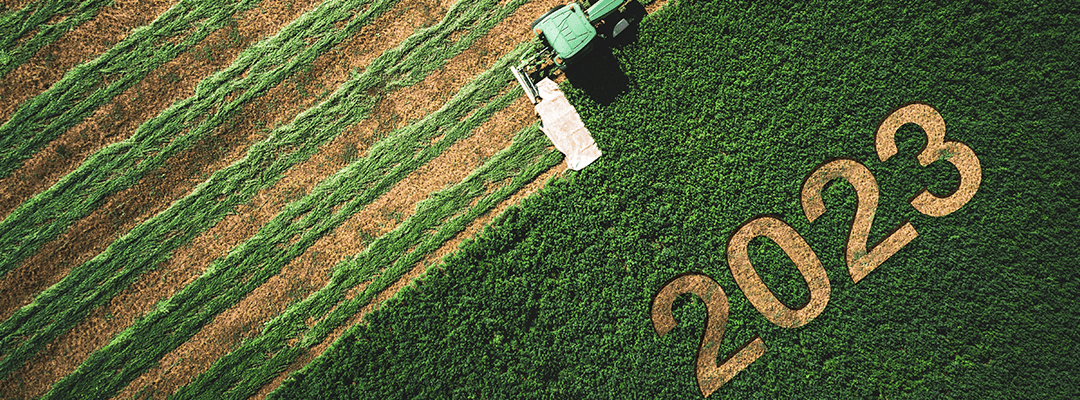As we enter 2023, what are you most looking forward to? This New Year is bound to have some exciting things in the works for the agriculture industry. Like this past year, we can expect monumental strides in the development of technological advancements.
End-of-year reflections open the door for predicting upcoming trends and their impact in the new year. 2023 is right around the corner, so what can we expect this New Year? The 2023 ag trends focus on providing sustainable and efficient solutions to both the predicted and unknown challenges facing the industry.
Let’s dig into three ag trends we are forecasting for 2023.
Dirt Matters: Reinstating the Importance of Soil Quality
Soil is the foundation of agriculture; it ultimately determines the success of crop production. So, when we are dealing with issues regarding soil quality, we are potentially facing detrimental impacts to crop development.
As we are faced with the difficulties of a growing population and limited resources, technological advancements are pushing toward higher yields. With the growing population that needs food, promoting sustainable agricultural development while boosting productivity is in high demand. Starting from quite literally the ground up, boosting soil quality is going to have a span of positive impacts on agriculture and the world.
Regenerative agriculture is likely to be one of the key 2023 ag trends as the industry works towards optimizing soil. This focuses on maintaining soil health and directly advocating for sustainability. Instead of destroying or depleting our resources, regenerative agriculture works to improve the resources used. Seeking regenerative efforts are going to result in mitigating climate issues, boosting crop health, increasing yield, and many more benefits.
How does regenerative agriculture promote sustainability? With regenerative agriculture, there is an increase in soil biodiversity and organic matter – resulting in better crop health with less erosion and runoff. Not only this, but it also works to release the stored carbon that can remain in the soil for years. This carbon drawdown and improvement in the water cycle can assist in efforts to reverse climate issues, which are becoming a more prevalent topic in the ag industry.
Boosting Teamwork: Collaboration Within the Industry
Collaborating throughout different systems and development efforts allow the identification of what works, what doesn’t, and ensures you’re reaching accurate results, efficiently. One of the most significant 2023 ag trends is going to be making data more accessible to other farmers, researchers, agronomists, etc.
We are also beginning to reassert the importance of open-source tools in creating more effective and efficient workflows. Sharing data through fast, reliable software pushes accessibility and collaboration. More people can access the data they need by leveraging open-source tools. This will open more people to the knowledge and data they need to gain a legitimate understanding of the characteristics, behaviors, and performance of their fields and research plots.
Especially when it comes to ag research, collaboration is going to result in faster and more accurate data collection and methods. Whether it be determining the optimal tools to leverage or data sets already collected, efforts will be accelerated and more reliable. Having access to this data is not only going to result in accelerated workflows but also improve the entire process of research.
When we’re sharing our successes and failures, we are saving someone the time of researching and weighing options. By collaborating on data collection and analysis, we can see faster workflows and allow others the opportunity for deeper understanding. Ensuring more people are aware of and have knowledge of different aspects of their operation will result in a smarter, more efficient industry. The future is not relying on one large-scale corporation to solve all the issues. It is up to everyone in the industry to push toward a more productive, sustainable future.
Technological Advancements for the Future
Will technologies like remote sensing continue to be popular? Will we continue to see more futuristic equipment like autonomous tractors? How are they going to counteract unprecedented challenges?
Each year, we look forward to the new technological advancements we will see. Building on the prior year’s challenges and innovations, the New Year is expected to have newer and better technologies. Like Sentera’s DGR System, which made its debut towards the end of 2022, it will be exciting to see these technologies in use this upcoming season.
Over the past few years, machine learning and autonomous equipment have emerged in agriculture. This growth in popularity directly correlates with the labor shortage that has been ravaging the agriculture industry this past year. Especially since we are still dealing with the impacts of limited labor, ag technology provides more efficient alternatives.
Utilizing technologies like autonomous equipment, ag drones, and machine learning provides more precise and timely solutions. Especially with the macroeconomic issues following into 2023, leveraging different technologies will save time and reduce costs – making up for deficiencies caused by challenges with labor and supply.
As we look towards the New Year, we will continue making these strides in the capabilities and advancements in agriculture. This year will be about providing efficient and sustainable solutions to optimize outcomes and offset challenges. It is essentially all about minimizing costs, mitigating macroeconomic issues, and ensuring others are aware of ways to optimize their practices.


